

Pages in this Folder:

Related Folders:
See also Department Site Map
Support Provided by

Toronto Parks and Trees Foundation
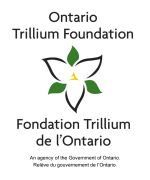
This website has received support from celos.ca through the Trillium foundation.
Publications
Comments?
For the basics, see
- Website & Privacy Policies
- How To Get Involved
- The Role of the Park
Search options:
Department Site Map
Custodians:
 Recent History
Recent History
Friends of Dufferin Grove Park: A Thumbnail History 1992 to 2004
See also Summer/Fall/Winter Story.
posted March 15, 2004
1992: Dufferin Mall's proposed expansion meets with hostility from the neighbourhood. Dufferin Mall offers $20,000 to the city for new playground equipment for Dufferin Grove Park, no strings attached. Parks Department calls a community consultation meeting but nobody comes. Mall manager David Hall calls Jutta Mason and asks her to consult neighbours. She calls around the neighbourhood for two days and asks people what they want for the park. Telephone consultation results: people ask for basketball court, adventure playground suitable for older kids, native species gardens, food in the park, more places to sit. Parks department calls community meeting at library. Well-attended meeting confirms this to-do list.
1993 - Big back yard founders
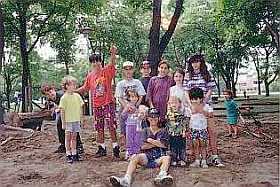
The sandpit
1993: June 15, sandpit is put into playground area, after "Friends of Dufferin Grove Park" is formed. July 5, mayor June Rowlands comes to open adventure playground. Summer drop-in activities, including enriched art program and our first cooking fires in "The Big Backyard." Late summer -- basketball court is built. That same summer the rink was rebuilt (scheduled previously). First children's garden is put in.
1994 -- February: official rink re-opening ceremony (on closing day). Summer -- second year of Big Backyard art activities. City funds film-maker Amnon Buchbinder to make 10-minute BBY movie. Second garden is put in with help from Latino gangsters.
1995: first bake oven is built (with help from the Trillium Foundation, Maytree Foundation, Ontario government "child nutrition grant," Parks and Recreation support). Mayor Barbara Hall comes to open oven. "Clay and Paper Theatre" takes up residence in orphaned park field house; field house vandalism is reduced. Dufferin Mall funds outdoor Sunday summer concerts.
1996 -- rink house is altered by community to allow better visibility -- city pays for installation of eye-level windows. New sign put up by city: "rinkhouse/clubhouse," with city-designed bake-oven logo. Friends of the park receive Canada Trust grant to put in more native species gardens. First summer giant puppet play is performed. Outdoor pizza days begin, for neighbourhood, schools, day camps, at bake oven.

1997 - rink "gangstas"
1997 -- more gardens are put in, near oven. Lieutenant Governor Hilary Weston comes to make pizza and be filmed by a CBC film crew. In winter, Parks and Recreation supervisor hires private security company to respond to calls for help from rink staff, ensure staff/ user safety in rink. More performances: Clay and Paper Theatre's summer puppet play and concerts.
1998 -- collaboration between Parks and Recreation and the "Friends" results in staffing changes at the rink. Park friends get a police-community partnership grant from the Ontario Solicitor General. Shakespeare's "Twelfth Night" is performed outdoors in the park. Family Sundays start at rink; private security contract cancelled (not necessary any more).
1998 - Rinkhouse chess
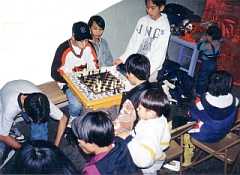
Private security no longer required
1999 - the Marsh Fountain wetland garden is put in by Gene Threndyle, with an Ontario Arts Council grant. Dusk Dances add Dufferin Grove Park as one of their summer performance venues. Clay and Paper Theatre's giant puppet play that summer is about the park: "The Ballad of Garrison Creek." Tours other parks on the creek bed.
2000 - a second bake oven is built as a workshop with city-wide participation. Dusk Dances and puppet plays continue. September 1: a violent incident on basketball court prompts the start of monthly park newsletter.
2001 -- In July, Park gets an international award in NYC as "Great Community Place," along with Chicago (accepted by their mayor), New York's Prospect Park, and Portland Oregon. Park friends begin to raise money by baking bread for Riverdale Farm farmer's market.
2002-- "Friends" apply to city for kitchen grant. Performances, etc, continue. Park farmers' market begins, Nov.7.
2003 -- Friday night suppers begin. "Friends" get Parks and Trees Foundation grant to start web site. Kitchen gets built. December 18: City of Toronto Corporate Services occupational health and safety inspectors arrive and say kitchen has to be destroyed, rink house can't be shared between zamboni and park friends.
2004 -- Zamboni movie made and shown on CBC; kitchen not destroyed. Food-related income reaches $30,000: all put back into extra park programs. "Friends" begin talking about how the funds raised can be processed by the City.
NOTE: none of this could have been done without close collaboration and continuous support from Parks and Recreation. The Friends of Dufferin Grove Park consider themselves an adjunct to Parks and Recreation.
Snapshots Over Time
posted February 27, 2007
Found Newspaper
The Dufferin Mall across the street from the park was the Dufferin Park Racetrack until 1956. A friend of Park Staff Mario Lourenco discovered these clippings from the Globe and Mail from 1953 while taking up some linoleum flooring in his house. One clipping is Appas Tappas' picks for the season opening horse race. The other is an advert for the races. The ad features the track's "Superb Cuisine" and "Excellent Service" full course meals from 75cents!! Today 75cents can still get you both excellent service and the superb cuisine of a mini-pizza at the Zamboni Cafe!
Click on the images for full size versions
posted February 13, 2006
Dufferin Rink, as painted by Samuel A. Bietenholz:
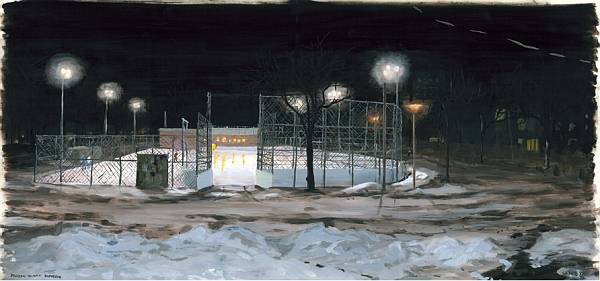
Artist Samuel Bietenholz painted this scene at Dufferin Rink. We found it in the "City Streets 2006" calendar (published by the Artists Foundation) and asked Sam if we could reproduce it here. We are very pleased now to share this with the neighbourhood, with permission. Thanks Sam!
For the full size image, click here, and expand your browser window to fill the screen.
posted March 15, 2004
Dufferin Mall...

...in another time
Dufferin Race Track:
Before 1955, the Dufferin Mall was a popular horse racing track, called "Dufferin Park." Rube Marcus, the owner of the famous rice-and-bean stand at St.Lawrence Market (downstairs in the south market building) told us that he used to go there a lot as a boy (he's over 80 now). He said that when he was 12, he figured out a great way to earn some money: he would buy a pound of peanuts for 10 cents and divide it up into 7 bags, which he sold at the racetrack for 5 cents each, on Saturdays in the winter. He said the bleachers weren't heated, and he used to stand over by the bookmaker's fire. The bookmaker always had a big campfire near the bleachers, and people would come over there to place bets and get warm. Rube said he sometimes made $2 or $3 a day.
The racetrack is gone but the campfire refuses to leave. It just migrated across the street to our park.
posted Februrary 24, 2006

Dufferin Rink, 1935
This is Adrienne Trent's mom Vivienne on Dufferin Rink in 1935. Adrienne's family lived on Havelock Street.
From the January 22, 1913 edition of the Toronto Star:
Using City Parks
The Parks Commissioner yesterday drew attention to the insanitary conditions under which the Salvation Army occupy Dufferin Grove for camp meetings. It is said that one hundred people reside on the grounds for a month, and that they have no other sanitary conveniences than earth closets. Such a thing should not be tolerated for a moment. The Medical Health Officer is compelling the poor of Toronto to install proper lavatory accommodation, and cannot under the circumstances countenance the conditions said to exist at Dufferin Grove.
There is another aspect to the question. Good citizens are inclined to sympathize with the commendable aims of the Army, and other religious institutions which hold camp-meetings at Dufferin Grove. But should the city hand over a park for considerable periods of time to any denomination? Why should they not rent vacant land and leave the parks for the purposes for which they are maintained? It is a quesiton which many people are asking, and it is not prompted by any hostility to the sort of meetings for which parks are now used."
-- Found by Michael Monastyrskyj at the Toronto Archives


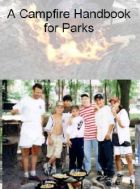
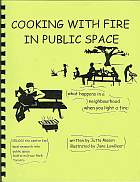


 Printer friendly version
Printer friendly version